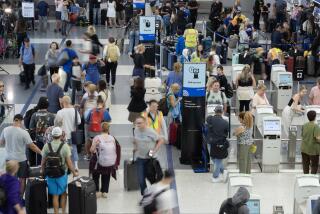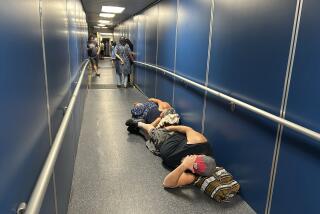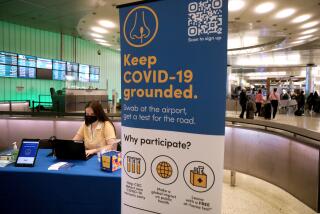How airport control towers keep operating after workers test positive for coronavirus
- Share via
When a traffic control tower worker at Palm Beach International Airport recently tested positive for the coronavirus, the staff evacuated the tower to allow for a thorough cleaning.
A makeshift tower to temporarily direct planes was then set up at the top of a nearby parking garage.
For the record:
11:20 a.m. April 17, 2020A previous version of this story said Metropolitan Transportation Authority bus drivers were meeting outside and were having their temperature taken twice a day. In fact, some MTA construction workers were meeting outside and asked to take their own temperatures twice a day.
2:24 p.m. April 13, 2020The name of the president of the National Air Traffic Controllers Assn. was misspelled in an earlier version. It is Paul Rinaldi.
The incident is one of several in the last few weeks that demonstrate how air traffic control workers have had to turn to creative alternatives to keep airlines operating in the midst of a pandemic that has so far infected more than 75 control tower workers across the country.
The workload for air traffic controllers has been lessened lately with airline traffic dropping by as much as 65% across the country and the demand for air travel in a nosedive over the last month.
But air traffic control workers say social distancing is nearly impossible in cramped towers, where a team of up to a dozen people work in a room no bigger than a small one-bedroom apartment.
The air traffic control room, known as a “cab,” at Los Angeles International Airport is about 800 square feet, but smaller airports have tower cabs about half that size.
“We have been completely collaborative with the FAA,” Paul Rinaldi, president of the National Air Traffic Controllers Assn., said in a recent conference call with union leaders in the aviation industry. “But we have to make sure that our workers are protected.”
Air traffic control workers aren’t alone in having to come up with new work policies to cope with the coronavirus outbreak.
The Los Angeles Police Department is taking the temperature of officers before each shift, and roll calls are conducted with officers spaced far apart to ensure an appropriate physical distance.
The Los Angeles Fire Department has accelerated the graduation of its next class of firefighters and has asked retired firefighters to volunteer to help during the crisis.
At the Fairplex in Pomona, a child-care center for the children of first responders and medical staff has divided the children into small groups and assigned them to separate rooms to reduce the chance that the virus can spread to all of them.
Some Metropolitan Transportation Authority construction workers have been holding meetings outdoors whenever possible and others have been asked to take their temperatures twice a day to slow the spread of the virus.
In the wake of dozens of air traffic control workers testing positive for the virus, the Federal Aviation Administration issued an internal memo in early April on how to schedule workers during the crisis. The memo, which was reviewed by The Times, called on each airport tower to divide the staff into crews, each with the minimum number of workers to operate a tower for one shift.
Employees will work with the same crew on all their scheduled shifts, the memo said. That way if a tower employee becomes infected, that person would expose only the other members of his or her crew and not members of other crews.
“This approach strives to ensure that social distancing practices are maximized while also supporting the mission of the agency,” according to the memo.
In addition, FAA workers are using portable communications equipment that allows them to continue to direct planes even when they have to abandon a control tower for a cleaning.
In large airports that have more than one control tower, such as Dallas-Fort Worth and Chicago O’Hare International Airport, one tower is kept as a “clean spare” in case the primary tower must be temporarily shut down for a cleaning after a worker tests positive for the virus, FAA representatives said.
At LAX, a retired control tower that was built in 1961 and is now used primarily for office space is designated as a backup for the current air traffic control tower, which opened in 1996.
Some of the nation’s largest airlines also have what is called a ramp tower, which operates like a control tower but is used instead by individual airlines to direct planes on the ground, moving along the tarmac and in and out of the gates.
On April 3, the Delta Air Lines ramp tower at Orlando International Airport temporarily replaced the main control tower after a tower control worker tested positive for the coronavirus and the FAA evacuated the tower for cleaning.
By keeping the Orlando airport open, the tower was able to land a plane that was carrying a passenger who was having a medical emergency, Doug Lowe, a technician at the Orlando tower, said in the union conference call.
“It was a good thing we did it,” he said. “There was quite a bit of traffic that continued to come in here.”
When another worker tested positive at Palm Beach International Airport a few days earlier, control tower workers took portable communications equipment to the top of a nearby parking garage, where they directed planes by sight until sunset, according to tower workers.
Once it was too dark to direct the planes by sight, the job of directing planes was turned over to the nearest Terminal Radar Approach Control, or Tracon, which directs planes in the airspace between airports.
In late March, the tower at McCarran International Airport in Las Vegas was closed for about a week after a tower worker tested positive for the virus and the rest of the tower staff was quarantined, FAA officials said. During that time, some flights were canceled and many more were directed into the airport by the Las Vegas Tracon.
“Each disruption has a distinct impact on the air traffic system,” the FAA said in a statement. “We are experiencing this at the handful of facilities already affected by COVID-19. This is frustrating and inconvenient, but is necessary in the interest of safety.”
More to Read
Inside the business of entertainment
The Wide Shot brings you news, analysis and insights on everything from streaming wars to production — and what it all means for the future.
You may occasionally receive promotional content from the Los Angeles Times.











